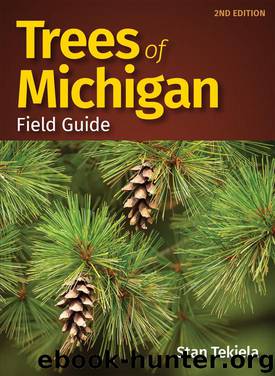Trees of Michigan Field Guide by Stan Tekiela

Author:Stan Tekiela
Language: eng
Format: epub
ISBN: 9781591939689
Publisher: Adventure Publications
Published: 2020-05-14T16:00:00+00:00
flower
bark
fruit
thorn
Russian-olive
Elaeagnus angustifolia
Family: Oleaster (Elaeagnaceae)
Height: 10–20' (3–6 m)
Tree: single crooked trunk that is often divided low, open irregular crown
Leaf: simple, lance-shaped, 1–4" (2.5–10 cm) in length, alternately attached, blunt tip or sharp tip, margin lacking teeth, gray above and below, leaves and twigs covered with grayish-white hairs
Bark: light gray with shallow furrows, thorns on twigs
Flower: 4-petaled yellow flower, ¼–½" (.6–1 cm) wide
Fruit: dry gray-to-yellow olive-like fruit, ¼–½" (.6–1 cm) diameter, containing 1 seed
Fall Color: brown
Origin/Age: non-native, introduced from Europe; 50–75 years
Habitat: wide variety of soils
Range: throughout, usually seen near old farmsteads and parks, formerly planted as an ornamental
Stan’s Notes: Was planted in North America for its unusual gray leaves and olive-like fruit, often as a shelterbelt. While it’s no longer planted, it has escaped from gardens, yards, and parks and now grows in the wild (naturalized). Spread by birds, which pass the seeds through their digestive tracts unharmed. Twigs are often scaly and armed with very long thorns (see inset) that have a salmon-colored pith. The species name, angustifolia, means “narrow leaf.” Also called Oleaster or Narrow-leaf Oleaster.
Download
This site does not store any files on its server. We only index and link to content provided by other sites. Please contact the content providers to delete copyright contents if any and email us, we'll remove relevant links or contents immediately.
The Lonely City by Olivia Laing(4122)
Animal Frequency by Melissa Alvarez(3759)
All Creatures Great and Small by James Herriot(3524)
Walking by Henry David Thoreau(3236)
Exit West by Mohsin Hamid(3192)
Origin Story: A Big History of Everything by David Christian(3142)
COSMOS by Carl Sagan(2958)
How to Read Water: Clues and Patterns from Puddles to the Sea (Natural Navigation) by Tristan Gooley(2871)
Hedgerow by John Wright(2781)
The Inner Life of Animals by Peter Wohlleben(2776)
Origin Story by David Christian(2690)
How to Read Nature by Tristan Gooley(2668)
Project Animal Farm: An Accidental Journey into the Secret World of Farming and the Truth About Our Food by Sonia Faruqi(2667)
How to Do Nothing by Jenny Odell(2648)
Water by Ian Miller(2595)
A Forest Journey by John Perlin(2588)
The Plant Messiah by Carlos Magdalena(2458)
A Wilder Time by William E. Glassley(2366)
Forests: A Very Short Introduction by Jaboury Ghazoul(2337)
